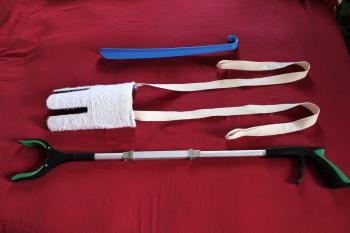Travel tips for the less able
This article appears on page 40 of the January 2020 issue.
Those were the good old days, when I could walk all day, race through airports, bound up and down metro station steps with multiple suitcases in hand, tackle museum after museum to maximize my city museum card, then climb up to my sixth-floor hotel room without breathing (too) hard. I remember running to catch trains, strolling through endless vineyards, climbing every tower and every steeple just because they were there and visiting all the booths at the Christmas market. Backtracking was not a chore; it was fun!
But things have changed. I am not exactly disabled, but I am less able. My most recent trip to Europe (October 2018) needed some serious tweaking due to my having had major back surgery in 2017. (My spine is now fused from my T10 vertebra to my pelvis, and I have a jungle gym of rods, screws and spacers inside me, making it nigh impossible for me to bend or twist.) I discovered that I can still travel, but I have to make adjustments and modifications to my previous routine.
Preparing for travel
Modifications begin long before departure day, and they are essential at the hotel-choosing stage. My husband, David, and I only look at hotels that have elevators and are in locations near public transportation, and we ask for a room with a shower instead of a bathtub. Checking photos and reviews online is an indispensable part of my trip planning.
Having a room with a desk or a luggage rack is high on our list so that I don’t have to bend to access my bag, and a roomy bathroom counter is needed for the same reason.
We scour hotel reviews to see if the beds are comfortable — not too hard and not too soft. We need either a king-sized bed (very difficult to find in Europe) or twins. A queen-sized bed no longer fits the bill because I have to “log roll” into bed, and I take up more than my fair share of space with the contortions required to change positions. (Think turtle on its back!)
Pre-trip research doesn’t always guarantee positive results, however. Hotels often list “lifts” without mentioning that not all floors are serviced by the elevator or that there are stairs to reach the hotel’s entrance, sometimes a full flight.
In addition, one person’s comfortable bed may not be at all comfortable for me. We had to change rooms in Amsterdam because the bed was too soft for my rigid rods. The room also had access only via a steep, curving staircase, which is normal in the Netherlands but very dangerous for the less able.
Trying to pack light is also a challenge, as I now carry three “helpers” with me so that I can dress myself. I have graduated from needing “Clint” walker and “Citizen” cane, but I still rely heavily on “Jack” reacher, which folds to fit into my carry-on.
I also pack a long shoehorn and a flexible sock aid made by SP Ableware that conveniently wraps around rolled clothing. Though these helpers do take up a little space, they make me less reliant on David and give me a modicum of independence, and I’ll take that over an extra change of clothes any day.
In place of a purse, I carry a Healthy Back Bag by AmeriBag. I have to be careful not to put too much into it, though, since no bag is back-healthy if it weighs too much! The only heavy item I carry is a water bottle, which fits in a pouch built into the bag. I have a super-slim travel wallet, and I empty coins frequently.
I no longer carry a guidebook (not even on a tablet). Instead, I rip out or photocopy the pages I want and carry just the ones I need for that day’s touring.
Making travel comfortable
In the air, I like my First Class Sleeper pillow by Travelon; it makes even coach class bearable. Since my surgery, I have found that booking premium-economy seats is well worth the extra fee, and I always choose an aisle seat so that I can frequently get up to stretch my back. I stretch my legs often, too, in addition to wearing compression socks.
I am no longer speedy, but I can still “schlep” a wheeled carry-on bag. When the time comes that I can’t, I will return to checking luggage. (We haven’t checked bags since 2007, when an airline lost both our suitcases for several days on a trip to Russia, followed by a different airline losing them on a trip to Italy… where mine was lost for a week!)
If our travels will involve renting a car, we look for one that’s not too low, and it must have a grab handle to help me swing my legs out. I use the First Class Sleeper in the rental car also, folded in half for lumbar support.
On our 2018 trip to Europe, we chose to get around using buses and trams instead of subways when we could to avoid any steps leading underground.
When we arrived at Paris’ Gare du Nord train station, we had a choice of taking the Métro — a straight shot to a station smack dab in front of our hotel — or a bus to a stop about three short blocks from the hotel. We chose the bus; I didn’t even want to think about hoisting a wheeled case from the Métro stop up to street level.
We could have taken a taxi from the airport, but the RER B train was an easy, comfortable ride to the Gare du Nord, which had elevators (ascenseurs) and escalators (escaliers roulants) up to the street.
We never used to bother with purchasing multiuse public transportation passes. In Paris, we would buy a carnet of 10 tickets to share for the few Métro rides we did take. Most of the time we walked.
However, knowing that we would be riding more on this last trip, we purchased Navigo Découverte passes in Paris and GVB multiday transportation passes in Amsterdam, along with Schiphol Airport Express tickets. We didn’t need separate airport transportation tickets in Paris because the journey was covered by our Navigo passes, which we purchased at the airport. What a joy in both cities to know we could hop on buses, trams or the Métro whenever we needed to!
Our Navigo passes, which covered travel from Monday through Sunday, cost €27.80 ($31) each, and our Amsterdam 3-day passes plus airport transfers cost €27.50 each.
Slowing our pace
We used to purchase museum passes and fill our days with “collecting” museums to get the most bang for our buck. While my love for museums has not diminished, my stamina has.
In Paris, we decided to visit the Musée d’Orsay, the Musée de l’Orangerie and the Musée de l’Armée at our own pace. By buying a combo ticket for the Orsay and the Orangerie, our three museum visits added up to €30 per person. A museum pass would have cost €48 per person for two days.
A major advantage to the museum pass, however, is that you can skip the ticket line, and we all know the ticket line at the Musée d’Orsay is usually très long, but we avoided that line by buying the combo ticket at the Orangerie, which often has only a short line.
In Amsterdam, we visited the Anne Frank House, the Rijksmuseum and the Van Gogh Museum, choosing just one per day. The total cost per person was €46. For us, the I amsterdam City Card (€95 for three days) was not worth it, even though it also covered transportation. (Not to mention, entry to the Anne Frank House [€10.50] was not included with the I amsterdam Card.)
Note: You must purchase your Anne Frank House tickets online for a specific date and time. Tickets are available two months in advance, and they go fast. And it is highly recommended that you book timed and dated tickets online for the Van Gogh Museum, though we were able to buy them the evening before our visit. We were glad we did because we saw signs at the museum entrance that only online tickets could be used that day.
To save our weary bones, we took elevators or escalators in all the museums that had them. If you take the elevator in the Van Gogh Museum, be aware that the paintings on each floor are arranged in chronological order from the stairway, which is nowhere near the elevator.
Finally, we made sure to take out travel insurance, and we signed up for lifetime evacuation and transportation insurance with Medical Air Services Association (MASA Assist, Plantation, FL; 800/643-9023, masaassist.com).
If you are facing similar challenges, don’t stay home. Even the less able can travel well. Just remember to travel wisely.


-itok=RSiU8CHE.jpg)
